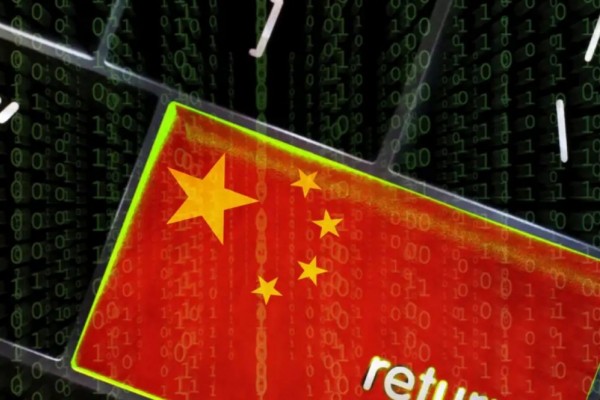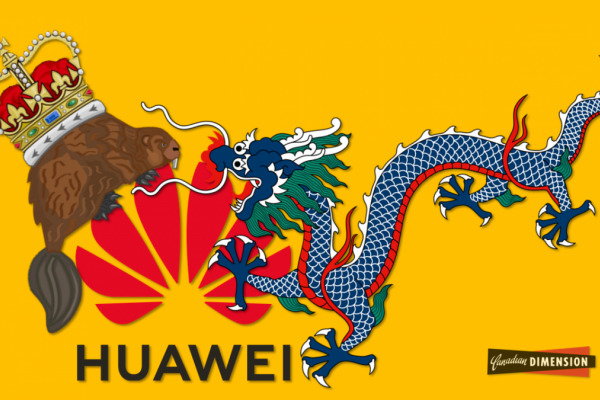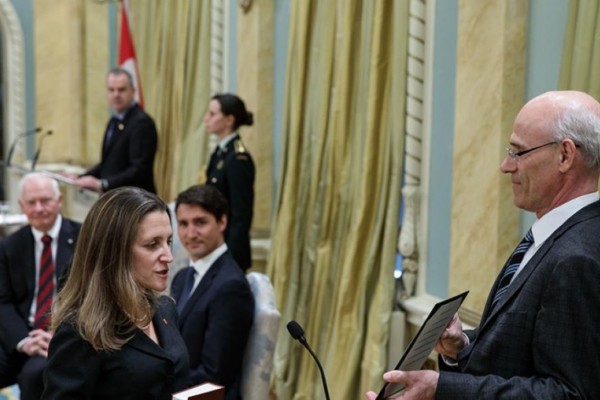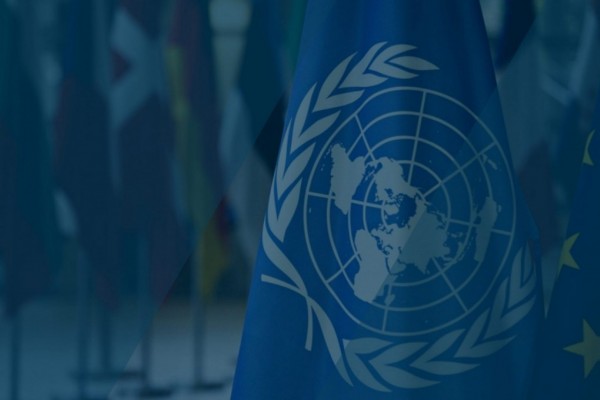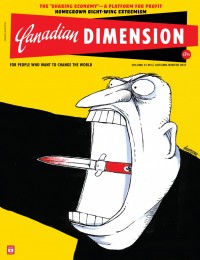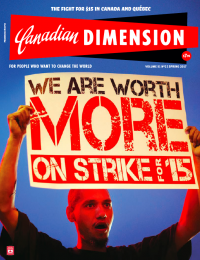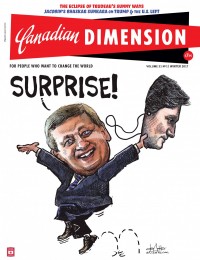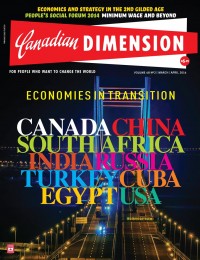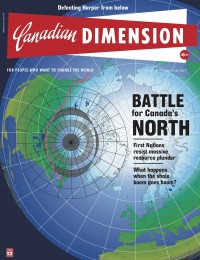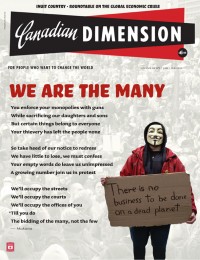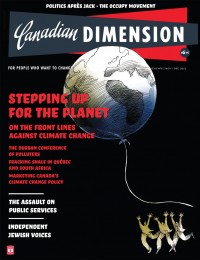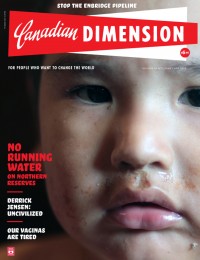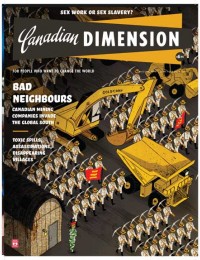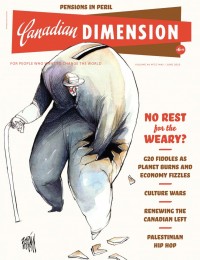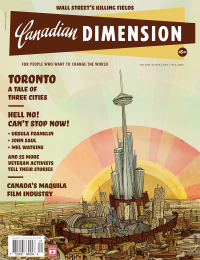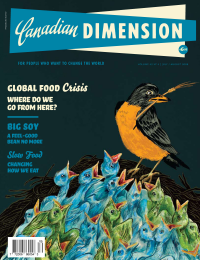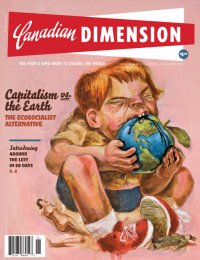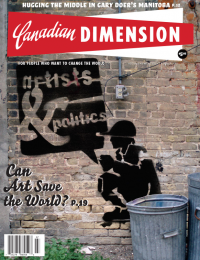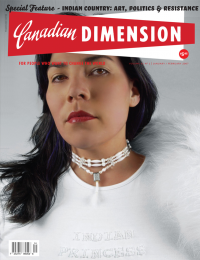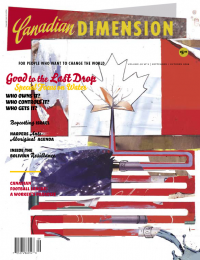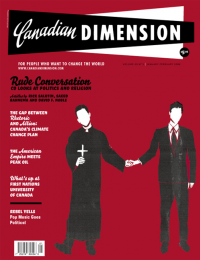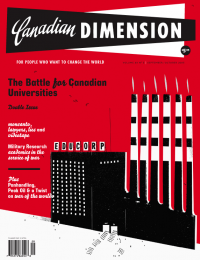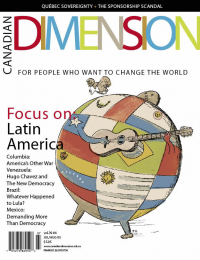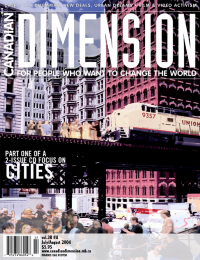Canada and the new Cold War
Is Ottawa delinking its economy from China’s to prepare for a direct military confrontation, all at the behest of Washington?

Why is Canada confronting China?
The Canadian government is directing a huge amount of resources toward confronting China. This confrontation goes way beyond the judicial kidnapping of Huawei’s Meng Wanzhou—it is military, economic, and political in nature, with far-reaching ramifications for Canada’s foreign and domestic policy. It is done in full coordination with the United States. It involves ignoring the most pressing issues in Canadians’ daily lives—rising rent and housing costs, growing food insecurity, profiteering by grocery monopolists, climate change—in favour of a militarist, resource-consuming anti-China policy that is in effect a carbon copy of Washington’s. It is part of the Western world’s desperate attempt to preserve its hegemony faced with the defiant assertions of sovereignty on the part of China, Russia and much of the Global South.
Fearmongering efforts aimed at the domestic audience seek to make ordinary Canadians accept the idea that China is an enemy. But while anti-China fearmongering has been a feature of Canadian politics for years, CSIS recently brought “yellow peril” fears to a fever pitch by manufacturing the “Chinese interference” scandal, which drove all major parties to call for investigations against accused MPs even as the allegations, such as those against Han Dong, fell apart.
All parties are on board for the confrontation with China. Politicians in the Liberal Party, the Conservative Party, and the NDP are constantly trying to out-warmonger each other. For instance, when the US and the UK agreed to supply Australia with nuclear-powered military submarines as part of the AUKUS security pact (a pact obviously directed against China), it was no surprise that the Conservatives lambasted Trudeau for not being part of the agreement. But even NDP leader Jagmeet Singh positioned himself to the right of Trudeau by criticizing Canada’s absence and declaring, “The pact seems like a potential avenue to add more pressure [on China].” Such is the sorry state of the New Democrats.
At the same time, Canada is expanding its military presence in the Pacific by increasing arms sales to regional allies like Japan and upping its participation in the US-led RIMPAC military exercises. Canadian warships have also been participating in provocative joint transits through the Taiwan Strait with the US, mostly recently on June 3, when the frigate HMCS Montréal accompanied the US Navy’s guided-missile destroyer USS Chung-Hoon. Having previously joined the US on transits through the strait, the Canadian military was well aware of Beijing’s view on hostile ships sailing off its coast—thus, it should have come as no surprise that a Chinese warship intercepted the US and Canadian vessels.
After the incident, Chinese Defence Minister Li Shangfu accused the US and its allies of “meddling in China’s internal affairs,” adding, “The best way [forward] is for the countries, especially the naval vessels and fighter jets of countries, not to do closing actions around other countries’ territories.”
While Canada and the US wave away criticism of these actions, asserting that they simply want a “free, open, and inclusive Indo-Pacific,” they are aware of how Beijing views these moves: as aggressions. One can certainly imagine how Washington or Ottawa would react if Russia and China organized joint military transits a short distance from their coastlines.
The same day Beijing criticized the joint US-Canada transit, Canadian Defence Minister Anita Anand announced that Canada will “significantly enhance its military presence in the Indo-Pacific,” which will involve “the annual deployment of an additional warship to the region, increased Canadian participation in international exercises, and strengthened relationships with regional partners through increased security cooperation.”
Anand also announced the signing of a ten-year memorandum of understanding (MOU) with South Korea, which is currently led by the hawkish far-right President Yoon Suk Yeol, who has increased military cooperation with the US and endorsed launching a “pre-emptive strike” against North Korea. The press release explains that the MOU is aimed at “allowing defence scientists [in Canada and South Korea] to share information and identify potential future partnerships,” and “facilitat[ing] collaboration between our respective defence organizations, which may include the exchange of information, scientists, and engineers.”
New military partnerships are not the only agreements Canada is pursuing in the Pacific. Ottawa is also attempting to build a new supply of critical minerals, which are mainly used to produce “green” technologies including wind turbines, semiconductors, solar panels, electric vehicles (EVs), EV batteries and motors, to say nothing of new military hardware. Many of the minerals needed to manufacture these products are under Chinese control. Moreover, the technologies used to produce such products and especially EVs are largely a Chinese monopoly. Canada, the US, and the EU have committed themselves to cooperate with one another in challenging Chinese dominance over what is regarded as a strategically decisive sector of the world economy.
China and the West’s protectionist shift
Ninety percent of the world’s rare earths production is located in China. China also controls the expensive processing and refining of these minerals—key links in the production chains of high-tech manufacturing and the defence industries in the US and its allies around the world. More than 70 percent of global EV battery manufacturing capacity is in China, while the US has less than 10 percent. Of the 142 lithium-ion battery megafactories under construction worldwide, China will be home to 107 of them. Just nine will be in the US. China also produces more than 60 percent of the world’s cathodes and 80 percent of anodes for batteries, and the majority of the world’s permanent magnets used in EV motors.
In question is the future of the world’s transportation systems. China is already seriously contending with the United States for world economic and political primacy. Continued Chinese dominance in rare earths could prove to be a decisive advantage. In response the West, including Canada, has moved toward establishing supply chains independent of China. This competition has become part of the West’s campaign to somehow stop China’s economic and political ascent. It is part of the overall move of the US and its friends away from globalization and toward protectionism, national industrial policies, and trading blocs. It does not portend well for the future of the world economy whose expansion requires open trade rather than protectionism and commercial wars. One is reminded of earlier trade wars, for example, over oil, which played a part in the wars of the twentieth century.
Canada’s Critical Minerals Strategy
A central focus of Canadian domestic and foreign policy right now is the Critical Minerals Strategy (CMS), announced last year. A national and provincial-level policy, the CMS aims to secure a steady supply of minerals needed to produce sustainable technologies—aluminum, copper, cobalt, gallium, lithium, nickel, zinc, rare earth elements, and more. In total, the Canadian government has identified 31 minerals as part of its CMS.
With many governments adopting “sustainable transition” goals, the demand for these minerals is high and only rising. According to a 2020 paper by the International Energy Agency (IEA), massive amounts of critical minerals will need to be produced to achieve these goals: 40 times more lithium and 20 to 25 times more graphite, nickel, and cobalt.
Canada, which is per capita the world’s largest or second-largest polluter, appears to be playing both sides of the “sustainable transition” debate. While subsidizing the fossil fuel industry to the tune of billions and lagging on climate promises, the Trudeau government is also funding critical minerals projects, arguing that these materials are necessary as Canada implements piecemeal climate reforms such as the promotion of EVs.
In Canada, hundreds of lithium mines are active or in the development stage. A wave of battery metals mining is spreading across the country, particularly in Québec and Ontario. Meanwhile, the Arctic territories are increasingly in the sights of government and industry, with Trudeau backing mineral extraction in the Northwest Territories and industry figures calling for more mining investment in Nunavut.
The CMS strategy, however, goes far beyond mining projects inside Canada. Encouraged by Ottawa’s financial and diplomatic support, mining fever is palpable in Canadian industry, to the degree that Canada’s mining companies are also leading the controversial charge to mine battery metals in the deep sea, which is “the world’s last largest intact wilderness refuge, a buffer against a warming climate and a treasure trove for undiscovered biomedical resources.”
As major corporations like BMW, Volkswagen, Google, and Samsung support a moratorium on deep-sea metals mining, Vancouver-based The Metals Company is pushing ahead, having signed exploration deals through subsidiaries with the Pacific islands of Nauru, Tonga, and Kiribati. Meanwhile, while numerous governments have supported pauses or bans on deep-sea mining, Ottawa is not one of them. The behaviour of the Canadian government and Canada’s mining industry is fuelling international worries that Ottawa aims to include the deep sea in its so-called “Western supply chain.”
Furthermore, as home to 75 percent of the world’s mining companies, Canada’s mining industry encompasses huge swaths of the Caribbean, Latin America, Africa, and Asia. Canada’s increasingly hostile relations with some countries, like China and Mexico, and cozy relations with other, like Peru and Ecuador, are absolutely influenced by the CMS.
Soil containing rare earths is transported for export at a port in China’s Jiangsu province. Photo by Reuters.
Critical minerals and Canada-China relations
The CMS is inherently geopolitical. When Canadian officials speak about the minerals in question, they often frame the issue through Canada’s reliance on China for the resources needed to transition toward a sustainable economy. Canadian officials have even spoken of a complete “decoupling” from China. Additionally, they have flown to Washington to pitch mineral extraction within Canada as an alternative to US imports from China.
Negotiations between Washington and Ottawa have resulted in plans by the US military to fund mining projects within Canada, an idea that the Trudeau government and Canadian mining companies were quick to accept. The US Defense Department’s direct involvement in the Canadian mining industry comes at the same time that Ottawa is pushing Chinese companies out of the sector on the grounds that foreign state-owned companies “threaten our national security.” The hypocrisy should be obvious to readers. Similarly, the Canadian government’s targeting of Chinese academics with alleged ties to China’s military—while overlooking the considerable presence of the US military on Canadian campuses—points to the ways that geopolitics are deforming Canadian academia as well as its industry.
Of course, there is an element of posturing to Ottawa’s moves. Even as diplomatic relations deteriorate, Canada-China trade is extremely significant, and Chinese companies remain involved in areas of the Canadian critical mineral sector such as the Tanco cesium mine in eastern Manitoba, which is owned by the private Chinese company Sinomine. Nevertheless, in October 2022, anti-China fervour pressured the Trudeau government to force Sinomine to divest from Canada’s Power Metals, a mining company specializing in lithium and cesium, even though Sinomine is not owned by the Chinese state. There are also political pressures in Canada to deny Sinomine a proposed expansion at Tanco.
While aiming to limit Chinese involvement in Canada’s critical minerals supply chain, Ottawa is keen to cooperate with other governments in Asia that take anti-China positions, including the far-right Yoon administration in Seoul. This is why, in May 2023, Trudeau signed a critical minerals agreement with Yoon, the stated purpose of which is to “counterbalance the influence of Beijing.”
The Trudeau government is using the rhetoric of “Canadian values” and “supply chain resilience” to justify its targeting of China, its support for Canadian mining companies abroad, and its subsidizing of domestic minerals and “green” tech operations. In May of this year, for instance, Ottawa announced $13 billion in subsidies for a Volkswagen EV factory in Ontario on the grounds that “autocracies around the world [i.e. China] are using supply chains to their advantage.”
Ecuador, Peru, and Canada’s “Western supply chain”
In Peru, one of Latin America’s most right-wing, violent, racist, and democratically illegitimate regimes in recent memory has maintained Canada’s ardent support due to Lima’s openness to mining investment. The same is true in Ecuador, where President Guillermo Lasso has fought all attempts to hold his blatantly corrupt and extremely unpopular government to account—at the same time that Ottawa is pushing for a Canada-Ecuador Free Trade Agreement that will give Canadian mining companies greater access to Ecuadorean minerals.
Peru and Ecuador contain huge reserves of many minerals identified by the Canadian CMS. Peru has some of the world’s largest reserves of bismuth, molybdenum, copper, tellurium, and zinc, as well as a notable amount of lithium. Ecuador possesses large deposits of antimony, copper, and rare earth metals.
Before Peruvian President Pedro Castillo’s removal in December 2022, he had planned to rewrite the country’s constitution, which was implemented under the dictatorship of Alberto Fujimori and gave enormous concessions to transnational mining companies. Following Boluarte’s usurpation of the presidency, the possibility of constitutional reform was thrown out the window, much to Ottawa’s approval—even though polls show that 69 percent of Peruvians agree their country needs a new constitution.
The Vancouver-based American Lithium company owns the Falchani lithium project in Peru, which is the sixth largest hard-rock lithium deposit in the world. During the pro-Castillo uprisings in Peru, which the government answered with massive repression targeted at the country’s Indigenous population, Canadian mining companies like American Lithium and the Trudeau government sided unequivocally with the Boluarte government. Clarke expressed the reasons for this in no uncertain terms: “The amount of lithium and other critical minerals we need to make this transition [to a ‘Western supply chain’] is huge… Peru is a big mining jurisdiction. Mining is protected in the constitution.” Castillo’s plans for constitutional reform clearly conflicted with Canada’s attempts to construct a new critical minerals supply, and Washington’s efforts to “box out” Russia and China from Latin America’s strategic resource supplies.
Critical minerals in Africa and Central Asia
Ottawa and Canadian companies have also promoted the expansion of Canadian mining in Africa. Pressured by the International Monetary Fund (IMF) and Western countries, African states began opening their mineral sectors to foreign investment decades ago. Canada played a significant role in this process. Ottawa leveraged aid to pressure African countries to adopt neoliberal reforms, and intervened directly in post-apartheid South Africa to ensure that the new state didn’t reform the apartheid-era mining laws from which Canadian companies benefitted. Current statistics illustrate the disproportionate influence that Canada has on African economies, particularly their mining sectors:
In 2020, 106 Canadian-owned mining companies operated in Africa… The most treasured countries, each containing Canadian mining assets valued at over $1 billion, are Mali, Mauritania, Burkina Faso, Ghana, the Democratic Republic of the Congo, Tanzania, Zambia, and South Africa. Some other less lucrative but nonetheless important countries, with Canadian assets valued between $100 million and $1 billion, are Senegal, the Ivory Coast, Niger, Namibia, and Botswana. Out of all these countries, Zambia is the most valuable for Canada-based companies, with Canadian-owned assets valued at around $10 billion—approximately half of Zambia’s total GDP…
It is a well-known fact that Canadian officials continue to interfere in the domestic affairs of African countries which aim to regulate the mining industry in ways Ottawa doesn’t like, as happened a few years ago in Tanzania. Nevertheless, Ottawa frequently decries the presence of Chinese mining companies in Africa, thereby disguising the widespread presence and unsavoury actions of Canadian companies and officials on the continent.
Since the invasion of Ukraine, Canadian mining giants have sought to increase their mining investments in Africa with the backing of the Trudeau government. The global quest for critical minerals has also increased interest in mineral exploration throughout the continent.
Additionally, Canadian mining companies have stepped up their engagement with countries in Central Asia. In early June of this year, a sizeable delegation of Canadian companies including Hatch, Cameco Corporation, Barrick Gold, Arras Minerals, Nutrien, Teck Resources, and B2Gold visited Kazakhstan’s capital of Astana to discuss increasing Canadian extraction of Kazakh minerals. Kazakhstan’s mineral supply includes bismuth, copper, manganese, molybdenum, titanium, and zinc, all of which are identified in Canada’s CMS.
The delegation to Astana is part of Canada’s growing economic engagement with Central Asia, a major part of which is related to mining investment. For instance, Canadian mining companies are heavily invested in Mongolian lithium, with the Toronto-based ION Energy describing its lithium investments there as playing “a key role in the supply chain.” Lithium exploration is also ongoing in Tajikistan and Uzbekistan as Western countries like Canada aim to diversify their supply of lithium outside the South American “Lithium Triangle,” where resource nationalism is a constant concern.
Prime Minister Justin Trudeau during his tour of the Vital Metals rare earths element processing plant in Saskatoon, January 16, 2022. Photo courtesy the Red Deer Advocate.
The geopolitics of “supply chain resilience”
What is lost in the constant talk about building a new critical mineral supply chain, one that is “resilient” and “secure,” is the fact that supply chains are innately geopolitical. We can see the geopolitics in a recent report by the Royal Bank of Canada (RBC) titled “Mission critical: Securing supply of critical minerals.” RBC’s report warns of governments around the world, including Chile and Indonesia, which are beginning to place “conditions on the use of some of their critical minerals in an attempt to boost their economies.” Resource nationalism is RBC’s main worry, as “Such nations can become unfriendly or unstable, and at the very least can make life difficult for international buyers.”
What are RBC’s solutions to the spectre of resource nationalism, an ever-present threat to Canadian supply chains? It has three:
- Reshoring critical mineral production to Canada, or else “friend-shoring” production to geopolitical allies. This solution has the benefit of “reduc[ing] vulnerabilities to regimes that may become unfriendly,” i.e., governments which decide to pursue independent economic policies.
- Securing mineral partnerships through “active diplomacy,” particularly on the African continent. The report notes: “the US and its allies are lobbying countries where mines will be built, providing financing for projects or helping to attract private investment… particularly across Africa given it is home to just under one-third of the world’s mineral resource deposits.”
- Reducing the need for some minerals, like cobalt, through technological improvements.
As the RBC report confirms, one of Canada’s primary concerns regarding “supply chain resilience” is the possibility of mineral-producing countries attempting to exert greater control over their natural resources. Even in the past few years, we can see how the Canadian government responds to such states. In the ongoing dispute with the Mexican government, Canada has used legal and diplomatic means to try to halt President Andrés Manuel López Obrador’s popular mining reforms, which would increase environmental protections and provide local communities with more input into extractive decision-making. In the cases of Venezuela, Bolivia, and Peru, Canada offered tacit or active support for the violent overthrow of the government whose actions endangered Canadian investments.
In many countries where Canadian investments are deemed secure, Canada-based mining companies operate with essentially no accountability, engaging in environmental destruction and repressing community protest through the host country’s police services or private security teams. The Canadian embassy frequently intervenes to ensure that Canadian mining companies can continue acting in this way, either by pushing specific projects or working to implement lenient mining laws in the host country—a fact that surely strikes readers as hypocritical given Canada’s current outrage at supposed Chinese interference.
Meanwhile, when those who suffer due to Canadian mining companies’ actions attempt to seek restitution inside Canada, the courts almost always reject their cases. When the family of Mariano Abarca, a Mexican community activist murdered by assassins connected to the Canadian mining company Blackfire Exploration, attempted to sue the Canadian government for reparations, their case was rejected by the Federal Court of Canada, the Federal Court of Appeal, and the Supreme Court of Canada. Facts like these are consistently elided in discussions of “supply chain resilience.”
What comes after supply chain resilience?
Let us assume Canada does build a resilient “Western supply chain” for critical minerals, through reshoring, friend-shoring, pro-mining diplomacy, successful interventions against nationalist states, technological improvements, or any combination of these factors. What comes next? If the Canadian state somehow enters an ideal world where its critical minerals supply is totally decoupled from China, what does that mean for Canada-China relations?
Given Ottawa’s increasingly belligerent actions in the Pacific, its growing military cooperation with states hostile to Beijing, and the openly antagonistic way Canadian officials discuss China, it seems that Canada wants to delink its economy from China’s in order to prepare for a direct military confrontation. And why would Canada actively plan for military confrontation with China rather than pursue avenues of peaceful coexistence? One could ask the same question of Canadian policy vis-à-vis Russia-Ukraine, which between 2014 and 2022 did everything possible to aggravate tensions between the two nations.
Canada is following Washington’s global agenda completely, which seeks to undermine both Russia and China to preserve the dominance of a US-led Western economic order. This is not only dangerous—it will never succeed, as war between the US and its allies on the one hand and China and Russia on the other will sooner lead to apocalypse than the restoration of ailing US hegemony.
Stripped of the geopolitics in which it is embedded, “supply chain resilience” sounds like a good thing. Ideally Canada would have a reliable supply of the resources needed to move the country toward an ecologically sustainable economy. But supply chains are not apolitical, and the Canadian elite does not treat them as such.
On the bilateral level, Ottawa deems mineral supplies “secure” only if Canadian mining companies are allowed to profit and act without accountability for the social and environmental consequences of their extractive enterprises. On the global level, Ottawa has allowed Washington’s Cold War on China to subsume Canada’s plans for a “sustainable transition,” meaning that policies like the CMS are inextricable from the Canadian military’s increased presence in the Pacific.
While rational nations would understand that the tide of history is not in the West’s favour and move toward some kind of accommodation with China, the unfortunate reality is that at the moment neither the US nor Canada appear rational in the slightest.
Owen Schalk is a writer from Manitoba. His book on Canada’s role in the war in Afghanistan will be released by Lorimer in September. You can preorder it here. To see more of his work, visit www.owenschalk.com.
Henry Heller is a Professor of History at the University of Manitoba. He is the author of The Birth of Capitalism: A 21st Century Perspective (Pluto Press, 2011), The Cold War and the New Imperialism: A Global History, 1945-2005 (Monthly Review Press, 2006) and The Bourgeois Revolution in France (Berghahn Books, 2006).





